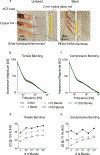Transparent, Low-Impedance Inkjet-Printed PEDOT:PSS Microelectrodes for Multi-modal Neuroscience
- PMID: 37641661
- PMCID: PMC10461862
- DOI: 10.1002/pssa.202100683
Transparent, Low-Impedance Inkjet-Printed PEDOT:PSS Microelectrodes for Multi-modal Neuroscience
Abstract
Transparent microelectrodes that facilitate simultaneous optical and electrophysiological interfacing are desirable tools for neuroscience. Electrodes made from transparent conductors such as graphene and indium tin oxide (ITO) show promise but are often limited by poor interfacial charge-transfer properties. Here, microelectrodes are demonstrated that take advantage of the transparency and volumetric capacitance of the mixed ion-electron conductor Poly(3,4- ethylenedioxythiophene) polystyrene sulfonate (PEDOT:PSS). Ring-shaped microelectrodes are fabricated by inkjet-printing PEDOT:PSS, encapsulating with Parylene-C, and then exposing a contact site that is much smaller than the microelectrode outer diameter. This unique structure allows the encapsulated portion of the microelectrode volume surrounding the contact site to participate in signal transduction, which reduces impedance and enhances charge storage capacity. While using the same 100 μm diameter contact site, increasing the outer diameter of the encapsulated electrode from 300 to 550 μm reduces the impedance from 294±21 to 98±2 kΩ, respectively, at 1 Hz. Similarly, the charge storage capacity is enhanced from 6 to 21 mC cm-2. The PEDOT:PSS microelectrodes provide a low-haze, high-transmittance optical interface, demonstrating their suitability for optical neuroscience applications. They remain functional after a million 1 V stimulation cycles, up to 600 μA of stimulation current, and more than 1000 mechanical bending cycles.
Keywords: PEDOT:PSS; impedance modeling; printing; transparent microelectrodes; volumetric capacitance.
Figures







Similar articles
-
Characteristics of Transparent, PEDOT:PSS Coated Indium-Tin-Oxide (ITO) Microelectrodes.IEEE Trans Nanotechnol. 2018 Jul;17(4):701-704. doi: 10.1109/TNANO.2017.2785627. Epub 2017 Dec 20. IEEE Trans Nanotechnol. 2018. PMID: 30745860 Free PMC article.
-
A fully transparent, flexible PEDOT:PSS-ITO-Ag-ITO based microelectrode array for ECoG recording.Lab Chip. 2021 Mar 21;21(6):1096-1108. doi: 10.1039/d0lc01123a. Epub 2021 Feb 1. Lab Chip. 2021. PMID: 33522526
-
Chronic intracortical neural recordings using microelectrode arrays coated with PEDOT-TFB.Acta Biomater. 2016 Mar 1;32:57-67. doi: 10.1016/j.actbio.2015.12.022. Epub 2015 Dec 12. Acta Biomater. 2016. PMID: 26689462
-
Durable scalable 3D SLA-printed cuff electrodes with high performance carbon + PEDOT:PSS-based contacts.Artif Organs. 2022 Oct;46(10):2085-2096. doi: 10.1111/aor.14387. Epub 2022 Sep 2. Artif Organs. 2022. PMID: 35971860 Free PMC article.
-
Design of adhesive conducting PEDOT-MeOH:PSS/PDA neural interface via electropolymerization for ultrasmall implantable neural microelectrodes.J Colloid Interface Sci. 2023 May 15;638:339-348. doi: 10.1016/j.jcis.2023.01.146. Epub 2023 Feb 3. J Colloid Interface Sci. 2023. PMID: 36746052
Cited by
-
Polymer Skulls With Integrated Transparent Electrode Arrays for Cortex-Wide Opto-Electrophysiological Recordings.Adv Healthc Mater. 2022 Sep;11(18):e2200626. doi: 10.1002/adhm.202200626. Epub 2022 Aug 19. Adv Healthc Mater. 2022. PMID: 35869830 Free PMC article.
-
Thin-film implants for bioelectronic medicine.MRS Bull. 2024;49(10):1045-1058. doi: 10.1557/s43577-024-00786-7. Epub 2024 Sep 26. MRS Bull. 2024. PMID: 39397879 Free PMC article. Review.
-
Recent Progress and Perspectives on Neural Chip Platforms Integrating PDMS-Based Microfluidic Devices and Microelectrode Arrays.Micromachines (Basel). 2023 Mar 23;14(4):709. doi: 10.3390/mi14040709. Micromachines (Basel). 2023. PMID: 37420942 Free PMC article. Review.
-
Label-free technologies for quantitative multiparameter biological analysis.Anal Bioanal Chem. 2009 May;394(1):121-35. doi: 10.1007/s00216-009-2637-8. Epub 2009 Feb 17. Anal Bioanal Chem. 2009. PMID: 19221722 Free PMC article. Review.
-
Overview of the Influence of Silver, Gold, and Titanium Nanoparticles on the Physical Properties of PEDOT:PSS-Coated Cotton Fabrics.Nanomaterials (Basel). 2022 May 9;12(9):1609. doi: 10.3390/nano12091609. Nanomaterials (Basel). 2022. PMID: 35564317 Free PMC article. Review.
References
Grants and funding
LinkOut - more resources
Full Text Sources
